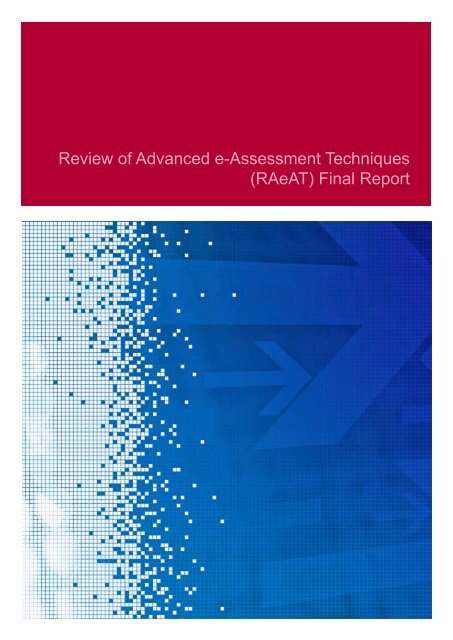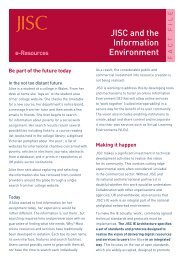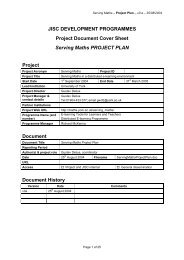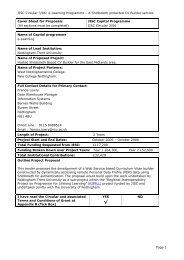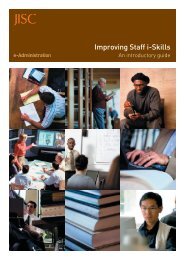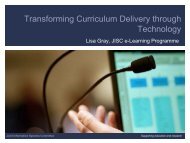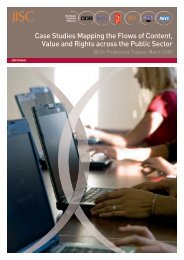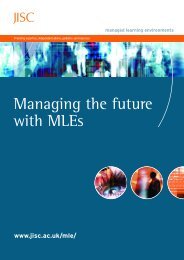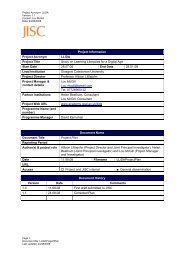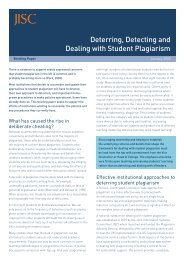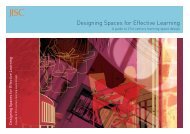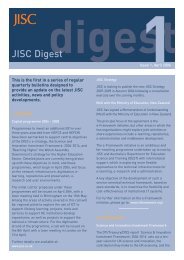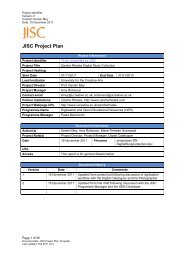Review of Advanced e-Assessment Techniques (RAeAT) Final ... - Jisc
Review of Advanced e-Assessment Techniques (RAeAT) Final ... - Jisc
Review of Advanced e-Assessment Techniques (RAeAT) Final ... - Jisc
You also want an ePaper? Increase the reach of your titles
YUMPU automatically turns print PDFs into web optimized ePapers that Google loves.
<strong>Review</strong> <strong>of</strong> <strong>Advanced</strong> e-<strong>Assessment</strong> <strong>Techniques</strong><br />
(<strong>RAeAT</strong>) <strong>Final</strong> Report
<strong>Review</strong> <strong>of</strong> <strong>Advanced</strong> e-<strong>Assessment</strong> <strong>Techniques</strong><br />
(<strong>RAeAT</strong>) <strong>Final</strong> Report<br />
Table <strong>of</strong> Contents<br />
Acknowledgements page 2<br />
Executive Summary page 2<br />
Background page 4<br />
Aims and objectives page 4<br />
Methodology and Implementation page 5<br />
Output and results page 7<br />
Outcomes and Impact page 11<br />
Conclusions and Recommendations page 13<br />
Implications for the future page 14<br />
References page 15<br />
Appendixes page 16<br />
Project Team<br />
Martin Ripley<br />
Robert Harding<br />
Hakan Redif<br />
Jim Ridgway<br />
Jeremy Tafler<br />
Contact: Martin Ripley<br />
martin.ripley1@btinternet.com<br />
Date: March 2009<br />
1
Acknowledgements<br />
This project and subsequent report was part <strong>of</strong> the JISC<br />
e-learning programme co-funded by the JISC Capital<br />
Programme and by Martin Ripley.<br />
The Project Team would like to acknowledge and thank the<br />
following individuals/institutions who were our case studies<br />
and/or provided valuable input and expertise into the case<br />
studies:<br />
John Hattie and Debra Masters at Visible Learning Labs,<br />
New Zealand<br />
Dr Mary McGee at the University <strong>of</strong> Manchester<br />
Brian Clauser at the National Board <strong>of</strong> Medical Examiners,<br />
USA<br />
Alison Fowler at the University <strong>of</strong> Kent<br />
Jared Bernstein and Alastair Van Moere at Pearson Versant<br />
Sally Jordon and Phil Butcher at the Open University<br />
Walter Williamson, John McEwen, Tom Mitchell at the<br />
University <strong>of</strong> Dundee<br />
Andrew Thravesat at GL<strong>Assessment</strong><br />
Jerry Podmore and Laura Lassman at Doublestruck<br />
We would also wish to thank Myles Danson and John<br />
Winkley for their invaluable guidance and review <strong>of</strong> our<br />
efforts.<br />
Executive Summary<br />
There is exciting and effective practice in e-assessment in HEIs<br />
in the UK but take-up is patchy. This is due to a number <strong>of</strong> wellrehearsed<br />
factors but there are signs that progress being made<br />
in the development <strong>of</strong> e-assessment packages may encourage<br />
the take-up <strong>of</strong> these techniques more widely.<br />
It is apparent from this study that e-assessment programmes<br />
have needed champions, both in the sense <strong>of</strong> the developer<br />
(<strong>of</strong>ten university-based, usually working in spare hours stolen<br />
from family or leisure time) and in the sense <strong>of</strong> institutional<br />
indulgence. Without these champions, potential academic endusers<br />
have found it unappealing to try and scale the walls <strong>of</strong> the<br />
new technology.<br />
What is changing is usability. Where previously much <strong>of</strong><br />
the preparatory work had to be done by third party or other<br />
technically expert staff, programs are increasingly providing<br />
end-user academics with the tools to implement their own<br />
e-assessment. The projects described in this report and five<br />
companion case studies show that benefits accrue. High<br />
quality, valid assessment can be performed which would not<br />
be economic without e-assessment; deadlines can be reached<br />
which would be otherwise unattainable. Not only is marking<br />
workload decreased, but information flow is increased. Tutors<br />
can easily check the efficacy <strong>of</strong> their teaching programmes;<br />
students can receive instant feedback on their learning;<br />
plagiarism is detected and discouraged; the impact <strong>of</strong> curriculum<br />
changes can be gauged.<br />
Change is attractive when it meets problems that are already<br />
appreciated. One <strong>of</strong> the obstacles to wider acceptance <strong>of</strong><br />
e-assessment is that it addresses issues that it has been all too<br />
easy to ignore. But increased demands for transparency, for<br />
timely feedback to students and for measuring teaching quality<br />
have raised the stakes. E-assessment <strong>of</strong>fers the means <strong>of</strong><br />
establishing students’ misconceptions and <strong>of</strong> correcting them, <strong>of</strong><br />
demonstrating and improving teacher effectiveness.<br />
The aim <strong>of</strong> this project is to provide JISC and its community with<br />
a review <strong>of</strong> state-<strong>of</strong>-the-art techniques in e-assessment which<br />
should be considered for application in UK Higher Education<br />
(HE) and Further Education (FE) settings. This review will<br />
contribute to other programme work to define and develop a<br />
roadmap <strong>of</strong> e-assessment research and development activities.<br />
The objectives <strong>of</strong> the study are:<br />
••<br />
To develop a picture <strong>of</strong> the breadth <strong>of</strong> advanced<br />
e-assessment techniques in use around the world, and<br />
undertake a technical and educational evaluation <strong>of</strong> a<br />
selection <strong>of</strong> the most promising;<br />
••<br />
To present short case studies describing the technical,<br />
educational and operational details <strong>of</strong> a selection <strong>of</strong> the most<br />
significant examples;<br />
••<br />
To look at wider generic technologies and investigate how<br />
and when these might be applied to e-assessment;<br />
••<br />
To draw conclusions about how the most relevant <strong>of</strong> these<br />
could be applied to UK FE and HE settings, and provide<br />
advice to JISC and its community about such application<br />
could be developed.<br />
The <strong>Review</strong> <strong>of</strong> <strong>Advanced</strong> e-<strong>Assessment</strong> <strong>Techniques</strong> project<br />
began by considering what constituted an advanced technique.<br />
“<strong>Advanced</strong>” refers to techniques that are used in isolated<br />
or restricted domains, and which have successfully applied<br />
technology to create an assessment tool. “<strong>Advanced</strong>” does not<br />
necessarily imply “newness”.<br />
The first stage within the project was to collate top-level<br />
descriptive information about potential candidates for further<br />
study in the project. This long-list ultimately contained over ninety<br />
projects. It was a surprise to the project team how few previously<br />
unknown advanced e-assessment projects came to light through<br />
the trawls for information. The community <strong>of</strong> experts and<br />
departments using e-assessment is small, and this continues to<br />
have implications for scaling e-assessment and for stimulating<br />
the growth <strong>of</strong> additional innovative approaches.<br />
The project team had expected to find secure examples <strong>of</strong><br />
e-assessment techniques being developed within Web2<br />
environments. Although environments such as Second Life are in<br />
use as social and learning environments, this project found little<br />
evidence <strong>of</strong> summative or formative assessment applications.<br />
We did identify a number <strong>of</strong> peer-to-peer assessment tools (such<br />
as Caspar at Bournemouth University and CAP at Glamorgan<br />
University), but considered that the generalisable issues relating<br />
to peer-to-peer have been well documented though the WebPA<br />
project. We also collected information about several other<br />
projects – such as TRIADS and eSCAPE – which certainly fulfil<br />
our criteria for “advanced techniques”, but we did not include<br />
further study <strong>of</strong> these as much has already been published.<br />
ePortfolios generally were not included as this assessment<br />
approach has been reviewed by a number <strong>of</strong> other JISC projects.<br />
During the initial collection <strong>of</strong> information about advanced<br />
e-assessment techniques, the project team sought a range <strong>of</strong><br />
projects covering as many different aspects <strong>of</strong> the assessment<br />
process as possible. We divided assessment business<br />
processes into three broad stages:<br />
Pre-hoc process<br />
Test<br />
administration<br />
Post-hoc<br />
processes<br />
This stage covers all processes prior to students<br />
completing a test, including processes such as<br />
authoring test items and preparing/printing the<br />
test papers.<br />
This stage covers all processes involved in<br />
students sitting a test or examination on a<br />
specific date.<br />
This stage covers all business processes that<br />
take place after the student has completed the<br />
test and might include, for example, marking and<br />
moderation.<br />
In order to cover as broad a range as possible <strong>of</strong> these<br />
processes, we investigated a number <strong>of</strong> international projects,<br />
and looked at projects from the schools and pr<strong>of</strong>essional training<br />
sectors.<br />
A catalogue <strong>of</strong> all the <strong>Advanced</strong> e-<strong>Assessment</strong> Projects has<br />
been published at http://www.dur.ac.uk/smart.centre1/aeac<br />
A total <strong>of</strong> five case studies have also been researched and<br />
written. Each <strong>of</strong> the case studies was selected and organised<br />
either around a specific e-assessment theme, or to investigate<br />
and describe a single e-assessment project. The case studies<br />
were as follows:<br />
Formative assessment<br />
The focus <strong>of</strong> this case study is AsTTle. The main function <strong>of</strong><br />
AsTTle is to provide users (tutors or teachers) with a system<br />
which enables them to specify and select test items to configure<br />
a test. The selection might be predicated on a focus on a<br />
particular curriculum domain, for example, or on the demand<br />
<strong>of</strong> the test items. The benefits <strong>of</strong> such a system derive from<br />
the ability to provide teachers with access to large, high-quality<br />
and calibrated item banks whilst also providing them with the<br />
flexibility to create test forms which closely reflect their teaching.<br />
Interestingly, AsTTle is an application developed in HE (in New<br />
Zealand), but providing services to school teachers.<br />
http://www.tki.org.nz/r/asttle/<br />
Higher Order Skills<br />
Some advocates <strong>of</strong> e-assessment point to the potential<br />
<strong>of</strong> computers to support simulation and scenario-based<br />
assessment. There are few examples <strong>of</strong> this category <strong>of</strong><br />
e-assessment being developed successfully, especially not<br />
in high stakes testing contexts. Primum is an exception. It<br />
provides an assessment <strong>of</strong> trainee medical practitioners’ ability<br />
in making medical diagnoses when presented with a fictitious<br />
patient exhibiting a number <strong>of</strong> symptoms. This automated<br />
assessment has been designed to provide an authentic and<br />
reliable assessment at a price that compares favourably with the<br />
alternative – human scored evaluation at patients’ bedsides.<br />
http://www.usmle.org/Orientation/2009/menu.html<br />
Combining human and computer marking<br />
Few e-assessment systems are designed to drive efficient<br />
marking by automatically sorting and classifying students’<br />
responses, then directing the sorted listing <strong>of</strong> responses to<br />
human markers. <strong>Assessment</strong>21 does. The benefit <strong>of</strong> such an<br />
approach is that it delivers more efficient marking (a human<br />
marker can browse sorted responses, applying one judgement<br />
to multiple, identical responses) as well as supporting greater<br />
consistency in marking (a marker views all similarly constructed<br />
responses at one time and applies a single, common judgement<br />
to all <strong>of</strong> those similar responses).<br />
www. assessment21.com<br />
Automatic scoring <strong>of</strong> foreign language<br />
textual and spoken response<br />
Computers have only limited ability to analyse and score the<br />
grammatical complexity <strong>of</strong> written language, and accuracy and<br />
fluency in the spoken word. Two e-assessment applications<br />
which do are LISC and Versant. LISC provides a detailed<br />
analysis <strong>of</strong> the grammatical accuracy <strong>of</strong> sentences translated<br />
into a second language by students, supporting students in their<br />
understanding and application <strong>of</strong> grammatical rules. Versant<br />
provides an automated spoken language pr<strong>of</strong>iciency assessment<br />
2<br />
3
with applications as diverse as Dutch government citizenship<br />
tests, university entrance fluency tests, and air-traffic controllers’<br />
pr<strong>of</strong>iciency tests. By designing assessments <strong>of</strong> highly focused<br />
skill domains, both <strong>of</strong> these e-assessments deliver effective<br />
assessments <strong>of</strong> skills that are prohibitively expensive to provide<br />
in a human-scored system.<br />
http://www.cs.kent.ac.uk/people/staff/amlf/CALL/HTML/<br />
menu.html<br />
http://www.ordinate.com<br />
http://htk.eng.cam.ac.uk/<br />
Automatic scoring <strong>of</strong> constructed, short text<br />
responses.<br />
There are a number <strong>of</strong> e-assessment products which score shorttext<br />
responses. This case study provides a survey <strong>of</strong> current<br />
practice, with a particular focus on two systems – Automark and<br />
IAT. The strengths and limitations <strong>of</strong> short-test scoring are well<br />
understood and, although not a panacea, short-text scoring is<br />
a technically strong area <strong>of</strong> e-assessment. Short-text scoring<br />
systems provide the benefits <strong>of</strong> using constructed responses<br />
items (which can provide valid assessments <strong>of</strong> students’<br />
understanding and application <strong>of</strong> knowledge) and provide the<br />
technology-driven benefits <strong>of</strong> efficiency and accuracy.<br />
http://www.open.ac.uk/colmsct/<br />
www.dundee.ac.uk<br />
This review <strong>of</strong> advanced e-assessment techniques has found<br />
examples <strong>of</strong> innovative and well researched e-assessment<br />
techniques. However, there is little evidence that e-assessment<br />
is having a substantial and positive impact on learning and<br />
teaching in UK universities. The examples <strong>of</strong> advanced<br />
e-assessment techniques studies in this project suggest that<br />
e-assessment can provide some solutions to concerns regarding<br />
assessment practice in higher education in the UK:<br />
••<br />
e-assessment can <strong>of</strong>fer opportunities to broaden the range<br />
<strong>of</strong> assessment methods used in universities and colleges,<br />
where currently the monoculture <strong>of</strong> essays continues to<br />
prevail;<br />
••<br />
e-assessment <strong>of</strong>fers opportunities to derive efficiencies in<br />
assessment – by automating the scoring <strong>of</strong> some types<br />
<strong>of</strong> item; by providing better diagnostic feedback; and by<br />
providing more flexibility over the timing <strong>of</strong> assessment to<br />
students and their tutors.<br />
••<br />
e-assessment approaches could also provide routes to<br />
delivering greater consistency in assessment methods and<br />
standards between institutions.<br />
It is beyond the scope <strong>of</strong> this report to speculate why advanced<br />
e-assessment techniques are not more prevalent in HE. The aim<br />
has been to find examples <strong>of</strong> e-assessment from which JISC and<br />
individual institutions can gain confidence about the education<br />
value and technical robustness <strong>of</strong> e-assessment systems<br />
4<br />
Background<br />
The aim <strong>of</strong> the wider JISC e-Learning programme is to enable<br />
UK further and higher education institutions to create better<br />
learning environments. Its vision is <strong>of</strong> a world where learners,<br />
teachers, researchers and wider institutional stakeholders use<br />
technology to enhance the overall educational experience<br />
by improving flexibility and creativity and by encouraging<br />
comprehensive and diverse personal, high quality learning,<br />
teaching and research.<br />
The e-Learning programme also endeavours to provide a 'map<br />
<strong>of</strong> the territory', to provide guidance and support, and to focus<br />
development work where it will be most effective. It considers<br />
that technology should be exploited to free time from those<br />
activities that can be efficiently automated, and should be used<br />
to support innovative and creative approaches to teaching and<br />
learning.<br />
The <strong>Advanced</strong> e-<strong>Assessment</strong> <strong>Techniques</strong> Project and its<br />
findings, along with a number <strong>of</strong> other JISC- funded projects<br />
within the e-learning programme, will contribute to the overall<br />
e-strategy. By focusing on current, advanced e-assessment<br />
practices, the project will inform JISC regarding e-assessment<br />
techniques in use, which <strong>of</strong> these can be promoted in terms <strong>of</strong><br />
the educational value and technical robustness. The project has<br />
also been designed to provide evidence for JISC regarding the<br />
success <strong>of</strong> e-assessment projects as well as to contribute to the<br />
understanding <strong>of</strong> barriers to e-assessment.<br />
The project, undertaken by Martin Ripley Ltd (Martin Ripley,<br />
Jeremy Tafler, Jim Ridgway, Robert Harding, Hakan Redif),<br />
utilised the skills and knowledge <strong>of</strong> experts in the e-assessment<br />
and e-learning fields. This enabled a quick and productive start<br />
to the project, covering a wide range <strong>of</strong> case studies as well<br />
as developing a lengthy catalogue <strong>of</strong> e-assessment projects in<br />
action.<br />
Aims and Objectives<br />
The aim <strong>of</strong> the project was to provide JISC and its community<br />
with a review <strong>of</strong> state-<strong>of</strong>-the-art techniques in e-assessment<br />
which should be considered for application in UK HE and FE<br />
settings. This review will contribute to subsequent work to define<br />
and develop a roadmap <strong>of</strong> future e-assessment research and<br />
development activities within the JISC e-learning programme.<br />
This JISC study was designed to build a significant body<br />
<strong>of</strong> information about who is using different techniques, the<br />
associated issues and the benefits <strong>of</strong> advanced e-assessments.<br />
The objectives <strong>of</strong> the study were:<br />
••<br />
to develop a picture <strong>of</strong> the breadth <strong>of</strong> advanced<br />
e-assessment techniques in use around the world, and<br />
undertake a technical and educational evaluation <strong>of</strong> a<br />
selection <strong>of</strong> the most promising;<br />
••<br />
to present short case studies describing the technical,<br />
educational and operational details <strong>of</strong> a selection <strong>of</strong> the most<br />
significant examples;<br />
••<br />
to look at wider generic technologies and investigate how and<br />
when these might be applied to e-assessment;<br />
••<br />
to draw conclusions about how the most relevant <strong>of</strong><br />
these could be applied to UK FE and HE settings, and<br />
provide advice to JISC and its community about how such<br />
applications could be developed.<br />
The project has delivered the aims and objectives by:<br />
••<br />
identifying a range <strong>of</strong> advanced e-assessment techniques<br />
in use in HE and the wider environment that currently totals<br />
over 90 in number;<br />
••<br />
selecting and studying in depth seven projects covering the<br />
major areas <strong>of</strong> test and assessment systems: task/test design;<br />
administration; marking, scoring and making judgements.<br />
••<br />
obtaining information about:<br />
- the range <strong>of</strong> users <strong>of</strong> the selected techniques;<br />
- the educational and technological benefits;<br />
- the key issues.<br />
Agree<br />
Protocols<br />
Agree protocols<br />
and frameworks<br />
Develop and<br />
review protocols<br />
Pilot<br />
Conduct<br />
Fieldwork<br />
Preparation<br />
First phase<br />
<strong>of</strong> fieldwork<br />
Desk reviews,<br />
interviews<br />
and any visits<br />
The project aims and objectives have remained consistent<br />
throughout the duration <strong>of</strong> the project, and there were no major<br />
changes made either to those objectives or to the agreed<br />
approach that was taken to achieve the objectives. The following<br />
specific questions were identified by JISC for this project.<br />
••<br />
To what extent has the project and the related case studies<br />
contributed to increased knowledge <strong>of</strong> e-assessment?<br />
••<br />
What were the unanticipated outcomes?<br />
••<br />
To what extent have the project activities remained relevant<br />
to the strategic needs <strong>of</strong> the sector?<br />
••<br />
What does JISC need to do next as a result <strong>of</strong> conclusions<br />
emerging from the project?<br />
Responses are provided below in the Conclusions section.<br />
Methodology and Implementation<br />
Our methodological approach to this project was to adopt a case<br />
study design, applying this separately for the development <strong>of</strong><br />
the catalogue, the case studies and the technical review. Our<br />
approach, set out in the diagram below, is based on Yin’s case<br />
study methods 1 .<br />
Analysis &<br />
Findings<br />
Develop and<br />
review strategy<br />
Analysis<br />
Conclusions &<br />
Report Writing<br />
Findings<br />
workshop<br />
Outline main<br />
conclusions<br />
Report writing<br />
1<br />
Yin, R.K. (2003) Applications <strong>of</strong> Case Study Research, Second Edition, Applied Social Research Methods Series, Vol. 34, Sage Publications.<br />
ISBN 0 7619 2551 1 http://www.paperfree.co.uk/ Paperfree Systems Ltd – e-Portfolio system.<br />
5
Through this study we documented the administrative<br />
implications and benefits <strong>of</strong> advanced e-assessment techniques.<br />
This included:<br />
••<br />
Developing new approaches to crediting student<br />
performance;<br />
••<br />
Developing and improving psychometric theory;<br />
••<br />
Improving the feedback loop between assessment and<br />
learning;<br />
••<br />
Improving accuracy;<br />
••<br />
Speeding-up the marking stages;<br />
••<br />
Availability <strong>of</strong> assessments on demand.<br />
At the outset we compiled a list <strong>of</strong> advanced e-assessment<br />
techniques and identified users <strong>of</strong> those techniques. We<br />
trawled through the initial source references provided by JISC,<br />
supplementing these with our own. We reviewed existing JISC<br />
publications and consulted with JISC to ensure that we did not<br />
replicate existing information. We also used our own networks to<br />
identify additional applications. These included:<br />
••<br />
The e-<strong>Assessment</strong> Association, which now has over 250<br />
members including from Higher Education;<br />
••<br />
The European Union Joint Research Centre’s e-<strong>Assessment</strong><br />
Expert network, which includes members from countries<br />
across Europe and world-wide;<br />
••<br />
The 21st Century Learning Alliance and its associated<br />
networks, including Cisco, Oracle, Micros<strong>of</strong>t, BT and Intel;<br />
••<br />
Our own pr<strong>of</strong>essional network, which includes e-assessment<br />
experts in the USA, the Middle East, China and Australia;<br />
••<br />
Virtual conference archives, including CAA and the IAEA.<br />
The information gathered was collated into a spreadsheet.<br />
At an early stage the project realised that the initial target <strong>of</strong><br />
40 assessment techniques would be greatly surpassed. This<br />
therefore altered the approach <strong>of</strong> producing the catalogue from a<br />
s<strong>of</strong>t/hard copy format to a web-based tool. With over 90 projects<br />
identified by the end <strong>of</strong> November 2008, the project decided<br />
to stop populating the catalogue and to start work on selecting<br />
applications/techniques to become the focus for the case studies.<br />
held with JISC to discuss these candidates and to select projects<br />
which <strong>of</strong>fered the potential <strong>of</strong> becoming a worthwhile and useful<br />
case study. It was agreed that some <strong>of</strong> the case studies would<br />
be themed and that, as such, they would include analysis <strong>of</strong> two<br />
or more applications <strong>of</strong> the chosen e-assessment themes. Other<br />
case studies would each provide analysis <strong>of</strong> a single-project. The<br />
final selection can be viewed in the ‘Output and Results’ section<br />
below.<br />
After further research to confirm the feasibility and suitability <strong>of</strong><br />
each nominated case study, a total <strong>of</strong> five case studies were<br />
finally agreed. Three <strong>of</strong> the five were themed. In line with the<br />
agreed research methodology, a case study research pro-forma<br />
was created and reviewed independently, before being trialled<br />
on one <strong>of</strong> the chosen case studies. As a result <strong>of</strong> the trial, a few<br />
minor amendments were made to the pro-forma and interview<br />
tool. As appropriate, site visits or telephone-based interviews<br />
were arranged. A workshop was held with JISC to review<br />
earlier drafts <strong>of</strong> analysis and to agree an overall approach for<br />
the case study reports. Subsequent working drafts <strong>of</strong> the case<br />
study write-ups were shared with JISC for their input and with<br />
an independent expert (Robert Harding) to quality assure the<br />
reports. Drafts and final versions <strong>of</strong> the case study reports were<br />
checked with and ultimately sign-<strong>of</strong>f by the interviewees.<br />
The lessons learned are set out below:<br />
••<br />
As part <strong>of</strong> the project title, the word ‘advanced’ was<br />
interpreted in a number <strong>of</strong> ways, whether advanced in its<br />
development/trialling and uptake, advanced as in the cutting<br />
edge/innovative nature <strong>of</strong> the technology, or advanced in<br />
terms <strong>of</strong> accepted practice, ‘established’ or ‘in the market’. It<br />
may have helped the project in the early days <strong>of</strong> creating ‘the<br />
40+ list’ to have had a better articulated definition.<br />
••<br />
As with the word ‘advanced’, similar issues were experienced<br />
with the word ‘techniques’. In this project ‘techniques’<br />
were taken to cover a wide range <strong>of</strong> features, including<br />
‘applications’, ‘assessment methods’, ‘s<strong>of</strong>tware’, ‘projects’<br />
and ‘concepts’.<br />
which they contributed new understanding to e-assessment<br />
or whether the list should have been tightly focused on those<br />
that were <strong>of</strong> most interest in terms <strong>of</strong> innovation, cutting<br />
edge or proven success. In the event, it was agreed that the<br />
catalogue should contain all known projects, regardless <strong>of</strong><br />
the extent to which they replicated previous practice or added<br />
new approaches.<br />
••<br />
The level and amount <strong>of</strong> new, innovative developments were<br />
to an extent relatively unknown at the start <strong>of</strong> the project.<br />
From the existing research to date, it came as somewhat <strong>of</strong><br />
a surprise and disappointment to the project team that there<br />
are not more new, innovative developments or ‘advanced’<br />
projects being used.<br />
Outputs and Results<br />
This project produced three groups <strong>of</strong> outputs:<br />
1. An online catalogue <strong>of</strong> advanced e-assessment projects and<br />
initiatives.<br />
2. A series <strong>of</strong> five case study reports.<br />
3. A final report.<br />
Online catalogue <strong>of</strong> advanced e-assessment projects<br />
and initiatives<br />
The project was designed to capture brief details <strong>of</strong> 40+<br />
advanced e-assessment projects and initiatives. In the event,<br />
details <strong>of</strong> over 90 were captured. These details have now been<br />
made available through a Durham University website<br />
http: //www.dur.ac.uk/smart.centre1/aeac<br />
For each project or initiative, the website lists the following<br />
information:<br />
••<br />
Name <strong>of</strong> the project or initiative<br />
••<br />
Institution<br />
••<br />
Contact details <strong>of</strong> the individual or team leading the initiative<br />
••<br />
URL<br />
better seen as tools, such as PDAs; yet others describe<br />
“purposes” rather than being techniques (eg assessment<br />
impacting learning programmes).<br />
It was not an aim <strong>of</strong> this project to create a glossary <strong>of</strong> advanced<br />
e-assessment techniques. In the event, it was found that<br />
simply listing advanced e-assessment techniques is more<br />
complex than had been anticipated. However, the following<br />
list could be developed further into a more rigorously defined<br />
set <strong>of</strong> techniques. It should be pointed out, <strong>of</strong> course, that any<br />
single project or initiative typically incorporated more than one<br />
technique.<br />
Access<br />
The use <strong>of</strong> technology designed to enable a greater range <strong>of</strong><br />
students to understand and be able to take part in an assessment<br />
Accuracy <strong>of</strong> complex inputs<br />
The use <strong>of</strong> technology to measure the technical accuracy <strong>of</strong><br />
students’ responses, such as in foreign language translation<br />
exercises<br />
Adaptive testing<br />
<strong>Assessment</strong>s which deploy algorithms to analyse student<br />
responses during the test session and to vary the selection <strong>of</strong><br />
items presented to the student accordingly<br />
<strong>Assessment</strong> impacting learning programmes<br />
The use <strong>of</strong> technology to create dynamic links between the<br />
assessment and learning programmes<br />
<strong>Assessment</strong> on demand<br />
The use <strong>of</strong> technology to make assessments and tests available<br />
to students at a date and time <strong>of</strong> the student’s choice. This<br />
technique was also used to refer to assessment systems which<br />
gave the teacher or tutor choice over the timing <strong>of</strong> assessment<br />
(i.e. the timing decision was made as locally as possible.)<br />
Associated services (e.g. plagiarism detection)<br />
The use <strong>of</strong> technology to provide services allied to assessment<br />
and testing; sometimes not available in pre-technology forms<br />
It was agreed with JISC that case studies should cover<br />
advanced e-assessment issues broadly rather than in great<br />
technical depth. The advantage <strong>of</strong> this approach was considered<br />
to be two-fold: that a larger number <strong>of</strong> case studies could be<br />
produced, and the case study reports could be written for a wider<br />
range <strong>of</strong> audiences, without any particular emphasis on technical<br />
know-how.<br />
The project considered the 90+ initial entries into the catalogue,<br />
organised them according to the e-assessment techniques<br />
that each exemplified, and provided each with a grading based<br />
on success, innovation, popularity, applicability and general<br />
uniqueness. The outcome was that JISC was presented with a<br />
shortlist <strong>of</strong> 20 possible case study candidates. A meeting was<br />
••<br />
The attribution <strong>of</strong> ‘techniques’ to each <strong>of</strong> the projects in the<br />
catalogue has proved problematic. One issue is that some<br />
projects make claims (for example to be using “adaptive<br />
testing techniques”) although following subsequent research<br />
this was sometimes found not to be the case. A second<br />
issue is that there is a complex matrix-relationship between<br />
projects and techniques – for example, any one project<br />
might incorporate several techniques (eg, short-text scoring,<br />
adaptive, diagnostic feedback, when ready testing), although<br />
only one or two <strong>of</strong> those techniques could be described as a<br />
dominant feature <strong>of</strong> the project.<br />
••<br />
At the outset <strong>of</strong> the project, it was unclear whether we were<br />
listing all projects/techniques regardless <strong>of</strong> the extent to<br />
••<br />
A brief description<br />
••<br />
Details <strong>of</strong> the advanced e-assessment techniques used in the<br />
project or initiative<br />
In order to meet this project’s aim <strong>of</strong> identifying a range <strong>of</strong><br />
projects using advanced e-assessment techniques, it was<br />
first necessary to create a list <strong>of</strong> techniques. The list was<br />
created initially through a brainstorm, and then supplemented<br />
throughout the project by adding techniques and descriptors<br />
as we progressed. In the event, the list <strong>of</strong> techniques contains<br />
a multiplicity <strong>of</strong> approaches: some (eg fuzzy logic/pattern<br />
matching) are “advanced” in terms <strong>of</strong> the definition <strong>of</strong> “advanced”<br />
used in this paper – that the technique is not yet commonplace<br />
in HE assessment; others are not “techniques”, but are perhaps<br />
Complex mathematical responses<br />
Analysis <strong>of</strong> student responses which include mathematical<br />
expressions which appear in many forms and which might<br />
include algebraic or more complex formula-based expressions<br />
Data mining<br />
The use <strong>of</strong> technology to support data mining techniques.<br />
Diagrams<br />
The use <strong>of</strong> technology to enable the presentation <strong>of</strong> diagrams,<br />
graphs and related approaches in assessments, as well as<br />
enabling students to manipulate, draw and/or label diagrams by<br />
way <strong>of</strong> response<br />
6<br />
7
Expert judgement/support systems<br />
An application that uses a knowledge base <strong>of</strong> human expertise<br />
and algorithms to emulate decisions that would be made by a<br />
human<br />
Extended text<br />
The use <strong>of</strong> technology to support input and/or scoring <strong>of</strong> prose<br />
responses in excess <strong>of</strong> 20 words or so.<br />
Feedback<br />
The provision <strong>of</strong> information and analyses for tutors, teachers<br />
and students based on individuals’ and groups’ performance on<br />
tests and assessments<br />
Formative<br />
The provision <strong>of</strong> information and analyses for students where the<br />
primary purpose <strong>of</strong> this is to inform decisions about next steps in<br />
learning<br />
Fuzzy logic/pattern matching<br />
The use <strong>of</strong> string matching computer techniques to compare<br />
students’ test responses to predicted and expected answers<br />
Group work<br />
The use <strong>of</strong> technology to set students group assessments, and<br />
to use technology to collect information about the performance <strong>of</strong><br />
the group and, sometimes, to score individual’s contributions to<br />
the overall group performance<br />
Higher order skills<br />
The use <strong>of</strong> technology to assess students higher order skills,<br />
including process skills (e.g. problem solving) and behavioural<br />
attributes (e.g. persistence and logic)<br />
Interactive skills<br />
The use <strong>of</strong> technology to assess student’s ICT skills<br />
Knowledge<br />
<strong>Assessment</strong> <strong>of</strong> domain knowledge, potentially using a variety <strong>of</strong><br />
item types<br />
Marking combining human/computer<br />
The use <strong>of</strong> technology to filter responses which can be<br />
automatically marked, presenting to human markers<br />
all responses that were not predicted or that cannot be<br />
automatically scored for other reasons<br />
Mobile phones<br />
The use <strong>of</strong> mobile phones to present assessment tasks and/or to<br />
collect student responses using the phone as an input device<br />
could be used as a vehicle for presenting a range <strong>of</strong> types <strong>of</strong><br />
assessment, including those which are designed to assess<br />
performance in using virtual world functionality and interactivity<br />
New approaches to student performance<br />
The use <strong>of</strong> technology to design and present measurements <strong>of</strong><br />
student performance not undertaken in paper-based or more<br />
traditional assessment. These innovations could be relatively<br />
technically and psychometrically straightforward (eg using video<br />
to present assessment stimulus material) or significantly more<br />
sophisticated (use <strong>of</strong> technology to assess group work, for<br />
example)<br />
PDAs<br />
The use <strong>of</strong> PDAs to present assessment tasks and/or to collect<br />
student responses using the PDA as an input device. In some<br />
instances, the PDA might be used as the tutor’s assessment<br />
handbook, reminding the tutor <strong>of</strong> the assessment rubrics and<br />
requirements<br />
Peer assessment<br />
The use <strong>of</strong> technology to collect peer-to-peer assessment<br />
judgements, possibly including the use <strong>of</strong> technology to present<br />
the assessment evidence<br />
Practical skills<br />
The use <strong>of</strong> technology to assess motor skills, physical skills,<br />
performance evidence and other types <strong>of</strong> practical skills<br />
Process<br />
The use <strong>of</strong> technology to collect evidence <strong>of</strong> student’s process<br />
performances, such as methods used to solve problems<br />
Psychometric theory<br />
The design <strong>of</strong> new and adaptive forms <strong>of</strong> performance<br />
measurement, leading to advances in psychometric theory not<br />
based on linear, item-based and paper-based forms <strong>of</strong> testing<br />
Short free text<br />
The use <strong>of</strong> technology to capture and score students’ short free<br />
text responses to test items.<br />
Speed<br />
The assessment <strong>of</strong> time-based aspects <strong>of</strong> students’<br />
performance, including the speed <strong>of</strong> their responses<br />
Training<br />
The use <strong>of</strong> technology to derive training-needs analysis, for<br />
instance by evaluating gaps and weaknesses in students’<br />
performance.<br />
Web2 – flickr, wikis<br />
The use <strong>of</strong> social technologies as a platform for presenting<br />
assessment tasks and/or capturing evidence <strong>of</strong> student<br />
performance<br />
VLEs<br />
The use <strong>of</strong> Virtual Learning Environments to launch assessments<br />
<strong>of</strong> any type<br />
Case study reports<br />
On reviewing the catalogue <strong>of</strong> e-assessment projects to<br />
select some to study in greater depth through case studies,<br />
it was agreed with JISC that two types <strong>of</strong> case study would<br />
be research. The first type would look broadly at a particular<br />
Case Study Report<br />
and its focus<br />
AsTTLE<br />
Adaptive testing<br />
<strong>Assessment</strong> 21<br />
Combining human/computer<br />
marking<br />
Primum<br />
Higher order skills<br />
Foreign language textual<br />
and spoken<br />
Short text<br />
e-assessment technique, reviewing a number <strong>of</strong> initiatives to<br />
provide analyses <strong>of</strong> issues underpinning that technique. These<br />
thematic case studies examined Short Text, Foreign Language<br />
Textual and Spoken and Storage/databanks. The remaining<br />
case study reports take as their focus the specific e-assessment<br />
project.<br />
The table below summarises the case studies, also providing<br />
information about the name <strong>of</strong> the institution, lead contact and<br />
research completed.<br />
These five case study reports have been published as separate<br />
and stand-alone documents. They are available at http://www.<br />
dur.ac.uk/smart.centre1/aeac In brief, the case study reports<br />
cover the following content.<br />
Institution(s)/company Contact Research completed<br />
University <strong>of</strong> Auckland John Hattie Telephone, email and deskbased<br />
research<br />
University <strong>of</strong> Manchester Dr Mary McGee Email and desk-based research<br />
and site visit on 2 March 2009<br />
National Board <strong>of</strong> MEdical<br />
Examiners (NBME)<br />
Philadelphia USA<br />
Brian Clauser<br />
Telephone, email and deskbased<br />
research<br />
LISC – University <strong>of</strong> Kent Alison Fowler Email and desk-based research<br />
and site visit on 2 March 2009<br />
Pearson Versant<br />
Automark, University <strong>of</strong><br />
Dundee<br />
Jared Bernstein and Alistair<br />
Van Moere<br />
Walter Williamson, John<br />
McEwen<br />
Telephone, email and deskbased<br />
research<br />
Email and desk-based research<br />
and site visit on 20 January<br />
2009<br />
MUVEs & Virtual Worlds<br />
The use <strong>of</strong> Multiple User Virtual Environments or other types<br />
<strong>of</strong> Virtual World to conduct assessments. The virtual worlds<br />
Voice/performance skills<br />
The use <strong>of</strong> technology to capture voice (i.e. spoken word)<br />
evidence <strong>of</strong> performance<br />
8<br />
9
Adaptive testing<br />
The focus <strong>of</strong> this case study is AsTTle. AsTTle is an<br />
e-assessment application, the main function <strong>of</strong> which is to<br />
provide users (tutors or teachers) with a system which enables<br />
them to specify and select test items to configure a test.<br />
The selection might be predicated on a focus on a particular<br />
curriculum domain, for example, or on the demand <strong>of</strong> the test<br />
items. The benefits <strong>of</strong> such a system derive from the ability to<br />
provide teachers with access to large, high-quality and calibrated<br />
item banks whilst also providing them with the flexibility to create<br />
test forms which closely reflect their teaching. Interestingly,<br />
AsTTle is an application developed in HE (in New Zealand), but<br />
providing services to school teachers.<br />
Higher Order Skills<br />
Some advocates <strong>of</strong> e-assessment point to the potential<br />
<strong>of</strong> computers to support simulation and scenario-based<br />
assessment. There are few examples <strong>of</strong> this category <strong>of</strong><br />
e-assessment being developed successfully, especially not<br />
in high stakes testing contexts. Primum is an exception. It<br />
provides an assessment <strong>of</strong> trainee medical practitioners’ ability<br />
in making medical diagnoses when presented with a fictitious<br />
patient exhibiting a number <strong>of</strong> symptoms. This automated<br />
assessment has been designed to provide an authentic and<br />
reliable assessment at a price that compares favourably with the<br />
alternative – human scored evaluation at patients’ bedsides.<br />
Combining human and computer marking<br />
Few e-assessment systems are designed to drive efficient<br />
marking by automatically sorting and classifying students’<br />
responses, then directing the sorted listing <strong>of</strong> responses to<br />
human markers. <strong>Assessment</strong>21 does. The benefit <strong>of</strong> such an<br />
approach is that it delivers more efficient marking (a human<br />
marker can browse sorted responses, applying one judgement<br />
to multiple, identical responses) as well as supporting greater<br />
consistency in marking (a marker views all similarly constructed<br />
responses at one time and applies a single, common judgement<br />
to all <strong>of</strong> those similar responses.<br />
Automatic scoring <strong>of</strong> foreign language textual and<br />
spoken response<br />
Computers have only limited ability to analyse and score the<br />
grammatical complexity <strong>of</strong> written language, and accuracy and<br />
fluency in the spoken word. Two e-assessment applications<br />
which do are LISC and Versant. LISC provides a detailed<br />
analysis <strong>of</strong> the grammatical accuracy <strong>of</strong> sentences translated<br />
into a second language by students, supporting students in their<br />
understanding and application <strong>of</strong> grammatical rules. Versant<br />
provides an automated spoken language pr<strong>of</strong>iciency assessment<br />
with applications as diverse as Dutch government citizenship<br />
tests, university entrance fluency tests, and air-traffic controllers’<br />
pr<strong>of</strong>iciency tests. By designing assessments <strong>of</strong> highly focused<br />
skill domains, both <strong>of</strong> these e-assessments deliver effective<br />
assessments <strong>of</strong> skills that are costly to provide in a humanscored<br />
system.<br />
Automatic scoring <strong>of</strong> constructed, short text<br />
responses<br />
There are a number <strong>of</strong> e-assessment products which<br />
score short-text responses. This case study provides a<br />
survey <strong>of</strong> current practice, with a particular focus on two<br />
systems - Automark and IAT. The strengths and limitations<br />
<strong>of</strong> short-test scoring are well understood and, although not a<br />
panacea, short-text scoring is a particularly strong aspect <strong>of</strong><br />
e-assessment. Short-text scoring systems provide the benefits<br />
<strong>of</strong> using constructed responses items (which can provide<br />
valid assessments <strong>of</strong> students’ understanding and application<br />
<strong>of</strong> knowledge) and provide the technology-driven benefits <strong>of</strong><br />
efficiency and accuracy.<br />
Findings<br />
Through the process <strong>of</strong> compiling the <strong>Advanced</strong> e-<strong>Assessment</strong><br />
<strong>Techniques</strong> catalogue, we arrived at a number <strong>of</strong> findings.<br />
Gaps in the range <strong>of</strong> techniques in use<br />
F1 The project team found that there was very little<br />
evidence <strong>of</strong> some <strong>of</strong> the more advanced, Web2<br />
technologies being used for assessment purposes. Although<br />
social technologies, virtual worlds and learning environments are<br />
to be found throughout higher education, we found little evidence<br />
<strong>of</strong> assessments being conducted in these environments.<br />
Few recent additions<br />
F2 The project team found that the majority <strong>of</strong> projects<br />
listed within the catalogue were reasonably wellknown,<br />
with far fewer than expected new developments<br />
identified. It might be that the methods used to seek out projects<br />
were not sufficiently refined to find these newer projects:<br />
however, the fact remains that the e-assessment community(ies)<br />
does not know <strong>of</strong> many new up-and-coming e-assessment<br />
initiatives.<br />
The isolated nature <strong>of</strong> some projects<br />
F3 The project team found a number <strong>of</strong> projects which,<br />
although encompassing significant e-assessment<br />
expertise and relevant technical developments, remain<br />
essentially isolated and in some cases are continuing to be led<br />
by a single person. This lack <strong>of</strong> ‘spread’ <strong>of</strong> technologies and<br />
approaches is reflective <strong>of</strong> the earliest stages <strong>of</strong> an innovation<br />
cycle, in which the developments are led be a very small minority<br />
<strong>of</strong> early-adopters who are <strong>of</strong>ten the experts and gurus.<br />
The purpose <strong>of</strong> the case study reports is to provide detailed<br />
information to the JISC community about specific e-assessment<br />
developments. As such, the studies have been designed as<br />
stand-alone digests, rather being designed to inform strategic<br />
considerations. However, the following findings emerge from our<br />
case study research.<br />
The isolated nature <strong>of</strong> some developments<br />
F4 In parallel with finding F3 above, the case studies<br />
provide evidence <strong>of</strong> the difficulties in ‘growing’ the<br />
e-assessment application for wider use. The LISC study is an<br />
example <strong>of</strong> a highly reliable and technically specific<br />
e-assessment development which has been driven by a single<br />
person, which does not have sufficient funding or resource to<br />
take it to a next level <strong>of</strong> operation, and which has almost become<br />
caught in a set <strong>of</strong> circumstances that threaten to keep it small<br />
scale. Primum, Versant and short-text are all examples <strong>of</strong><br />
e-assessment developments which have achieved a very high<br />
level <strong>of</strong> technical robustness, with associated depth <strong>of</strong> research<br />
and with considerable surrounding expertise. And yet these<br />
technologies have not won wider adoption.<br />
The human factor and the need to<br />
F5 demonstrate business efficiencies<br />
Ultimately, e-assessment technologies are only likely<br />
to be adopted if tutors and students see the benefits. Advocates<br />
<strong>of</strong> e-assessment seek to point to three areas <strong>of</strong> potential benefits<br />
<strong>of</strong> e-assessment:<br />
• Enhancements to the validity <strong>of</strong> assessment<br />
• Business improvements – e.g., better diagnostic information,<br />
more flexibility over the timing <strong>of</strong> assessment, quicker<br />
marking and results notification<br />
• Supplier benefits – e.g., cheaper to run and a less risk-prone<br />
business<br />
It is clear from several <strong>of</strong> the case studies that delivering<br />
at least some <strong>of</strong> the above benefits is a necessary but not<br />
sufficient condition for wider adoption. Despite significant<br />
claims <strong>of</strong> being able to provide these types <strong>of</strong> benefit,<br />
a critical ingredient for the successful wider adoption <strong>of</strong><br />
e-assessment projects is an ability to overcome concerns<br />
and doubts about technology (i.e. a human perception<br />
factor) and an ability to demonstrate benefits to the tutor<br />
(usually in the form <strong>of</strong> time savings).<br />
Links across sectors<br />
F6 Several <strong>of</strong> the case studies related to e-assessment<br />
developments which originated in HE, but which have<br />
grown through adoption in other educational and training sectors.<br />
LISC was developed at the University <strong>of</strong> Kent; all <strong>of</strong> its current<br />
users are secondary school-based. AsTTle is run from the<br />
University <strong>of</strong> Auckland, providing e-assessment tools for schools.<br />
Versant technology grew out <strong>of</strong> highly specialised research and<br />
design at the University <strong>of</strong> Cambridge, and is now providing<br />
commercial success to Pearson. In selecting case studies with<br />
JISC, the project team also identified the fact that some<br />
e-assessment techniques are not being pursued within HE. The<br />
use <strong>of</strong> item banks, to share the highest quality test items across<br />
institutions is a practice found extensively in the UK schools<br />
sector, but not at all to the same extent within HE. Both at a<br />
practical and at a strategic level, therefore, the case studies point<br />
to the benefits <strong>of</strong> cross-sector collaboration in e-assessment.<br />
Conclusions based on the above findings are presented later in<br />
this report.<br />
Outcomes and Impact<br />
This JISC study was designed to build a significant body<br />
<strong>of</strong> information about who is using different techniques, the<br />
associated issues and the benefits <strong>of</strong> advanced e-assessments.<br />
The objectives <strong>of</strong> the study were:<br />
••<br />
To develop a picture <strong>of</strong> the breadth <strong>of</strong> advanced<br />
e-assessment techniques in use around the world, and<br />
undertake a technical and educational evaluation <strong>of</strong> a<br />
selection <strong>of</strong> the most promising;<br />
••<br />
To present short case studies describing the technical,<br />
educational and operational details <strong>of</strong> a selection <strong>of</strong> the most<br />
significant examples;<br />
••<br />
To look at wider generic technologies and investigate how<br />
and when these might be applied to e-assessment;<br />
••<br />
To draw conclusions about how the most relevant <strong>of</strong> these<br />
could be applied to UK FE and HE settings, and provide<br />
advice to JISC and its community about how such application<br />
could be developed.<br />
The project has delivered the aims and objectives by:<br />
••<br />
identifying a range <strong>of</strong> advanced e-assessment techniques<br />
in use in HE and the wider environment that currently totals<br />
over 90 in number;<br />
••<br />
selecting and studying in depth five case studies covering<br />
the major areas <strong>of</strong> test and assessment systems: task/<br />
test design; administration; marking, scoring and making<br />
judgements.<br />
••<br />
obtaining information about:<br />
– the range <strong>of</strong> users <strong>of</strong> the selected techniques;<br />
– the educational and technological benefits;<br />
– the key issues.<br />
The evidence gathered throughout this project has also led to<br />
findings with wider implications for JISC. HE institutions differ a<br />
great deal; subject disciplines view knowledge in different ways.<br />
There exists a variety <strong>of</strong> views on the purposes <strong>of</strong> assessment<br />
in different subjects from pr<strong>of</strong>essional accreditation, through<br />
comparing standards in different institutions, to putting students<br />
10<br />
11
in a particular cohort into rank order. <strong>Assessment</strong> serves a great<br />
many functions: it can define what is worth knowing, and can<br />
steer teaching and student learning. From this perspective,<br />
e-assessment projects will <strong>of</strong>ten struggle to find common ground<br />
and users across a range <strong>of</strong> institutions.<br />
What (if any) problems are you trying to solve with the new<br />
system?<br />
••<br />
Efficient, frequent assessment <strong>of</strong> large numbers <strong>of</strong> students<br />
(and associated consequences for tutors in terms <strong>of</strong> marking<br />
How will the proposed system improve administrative<br />
systems?<br />
••<br />
By providing timely information? (e.g. LISC)<br />
••<br />
Loss <strong>of</strong> teacher autonomy; dependence on external support<br />
••<br />
Perceived loss <strong>of</strong> ownership by teachers, and student<br />
perceptions that a course is a mass product, not one<br />
designed with them in mind<br />
••<br />
Technical problems (resource implications, reliability, access<br />
In a fast developing field, one would hope to see developments<br />
at a number <strong>of</strong> levels – in particular, a ‘bleeding edge’ where<br />
enthusiasts pioneer novel approaches, and a fat tail where<br />
techniques <strong>of</strong> proven effectiveness are accepted and absorbed<br />
into the daily practices <strong>of</strong> institutions. A striking feature <strong>of</strong> this<br />
review is the lack <strong>of</strong> take-up <strong>of</strong> e-assessment in HE, despite the<br />
extensive development work that has taken place, and strong<br />
advocacy.<br />
A review <strong>of</strong> the literature on innovation is inappropriate here,<br />
but some summary remarks can illuminate the reasons for the<br />
current situation, and can suggest ways forward.<br />
Ridgway (2003) argued that users are likely to adopt some new<br />
way <strong>of</strong> working if:<br />
••<br />
It solves a problem they know they have got<br />
••<br />
It makes life more interesting and more fun<br />
••<br />
It makes life easier<br />
••<br />
It has a measure <strong>of</strong> social approval.<br />
It is easy to identify circumstances where e-assessment would<br />
fail on every category. Consider the application <strong>of</strong> automated<br />
essay marking to a specialist module taught by two tutors on<br />
a philosophy course. Currently, the tutors mark all the essays<br />
jointly. The work load is not high, and the task is interesting – so<br />
there is no problem to be solved. Automated assessment would<br />
remove an interesting part <strong>of</strong> the teaching, and would reduce<br />
job satisfaction because the tutors no longer read essays on<br />
a topic central to their research interests, and they lose the<br />
opportunity for discussions triggered by student conceptions<br />
and misconceptions. The task <strong>of</strong> assembling enough scripts to<br />
facilitate the automated scoring scheme is probably impossible.<br />
Further, an important source <strong>of</strong> evidence for revising teaching on<br />
the course has been lost. Students would complain vehemently<br />
about the lack <strong>of</strong> relevant feedback, and colleagues would be<br />
outraged by the conceptions <strong>of</strong> knowledge embedded in the<br />
procedure.<br />
However, it is possible to identify some fundamental questions<br />
and issues which new designers <strong>of</strong> e-assessment solutions<br />
might wish to consider. (A wider list <strong>of</strong> ‘questions to use when<br />
making decisions about investing resources in e-assessment’ is<br />
provided as Appendix Three.)<br />
workloads)?<br />
••<br />
Identification <strong>of</strong> and support for students’ knowledge and<br />
understanding? (e.g., the design <strong>of</strong> LISC to support student’s<br />
grammatical understanding in other languages).<br />
How will the proposed system improve teaching?<br />
••<br />
By providing more authentic assessment? (e.g. <strong>of</strong> difficultto-assess<br />
goals such as process skills and student reflection<br />
(e.g. Primum’s assessment <strong>of</strong> trainee medical practitioners’<br />
diagnostic skills, and Pearson Versant’s assessment <strong>of</strong> the<br />
spoken word.)<br />
••<br />
By improving teachers’ pedagogic knowledge? (e.g. by<br />
exposing teachers to student misconceptions by assembling<br />
all the answers to the same short question (e.g. Dundee))?<br />
••<br />
By providing a map <strong>of</strong> student performance on different parts<br />
<strong>of</strong> a course, as reflected by different questions<br />
••<br />
By removing drudgery from assessment? (e.g.<br />
<strong>Assessment</strong>21)<br />
How will the proposed system improve learning?<br />
••<br />
By providing feedback that is both timely (so that early<br />
mistakes do not develop into malknowledge (e.g. LISC),<br />
and useful (so that students are given guidance on how to<br />
improve their performances)?<br />
••<br />
By facilitating student autonomy and self regulation? (e.g.<br />
LISC)<br />
How will the proposed system improve the assessment<br />
system?<br />
••<br />
By drawing attention to the importance <strong>of</strong> good design in the<br />
creation <strong>of</strong> assessment tasks?<br />
••<br />
By increasing inter-marker reliability?<br />
••<br />
By raising awareness <strong>of</strong> key issues in assessment with<br />
academic staff (alignment, validity, reliability)?<br />
••<br />
Where appropriate (especially with large class sizes),<br />
widespread adoption <strong>of</strong> techniques that can help improve the<br />
design <strong>of</strong> assessment, such as routine use <strong>of</strong> psychometric<br />
techniques - examining various test reliabilities, means and<br />
variances <strong>of</strong> different components that contribute to students’<br />
overall grades, and using techniques associated with Item<br />
Response Theory? (e.g. <strong>Assessment</strong>21)<br />
••<br />
By increasing the variety <strong>of</strong> assessment, or time spent by<br />
staff giving feedback on some aspects <strong>of</strong> students’ work, if<br />
time is saved on routine aspects <strong>of</strong> marking? (e.g. LISC)<br />
••<br />
By increasing fairness?<br />
How will the proposed system address core goals <strong>of</strong> the<br />
university?<br />
••<br />
By supporting pr<strong>of</strong>essional dialogues between staff?<br />
The need to be clear about benefits<br />
F7 Linked to Finding F5, it became clear through the case<br />
study analysis that none <strong>of</strong> the case studies addressed<br />
very many <strong>of</strong> these questions and issues. Some <strong>of</strong> the questions<br />
and issues were not covered by any <strong>of</strong> the case studies. A more<br />
robust framework for analysing benefits to a wider range <strong>of</strong> users<br />
within HE institutions, and earlier efforts to secure stakeholders’<br />
involvement in and ownership <strong>of</strong> e-assessment developments<br />
might be helpful.<br />
It is possible also to go a significant step further. Generally, we<br />
tend to look at e-assessment projects to find interesting, useful<br />
and clever new techniques that they <strong>of</strong>fer. A different perspective<br />
is to analyse the assessment and related problems being<br />
experienced by HE institutions and to identify ways in which<br />
technology might be able to address these to a greater or lesser<br />
degree.<br />
For example, there are a number <strong>of</strong> serious concerns about<br />
current assessment practices in HE, which include:<br />
••<br />
Low inter-marker reliability<br />
••<br />
Comparability <strong>of</strong> qualifications across universities<br />
••<br />
The richness and variety <strong>of</strong> assessment practices (essentially<br />
that a monoculture <strong>of</strong> essays is not acceptable as a way to<br />
assess attainment)<br />
••<br />
Low quality feedback to students (in terms <strong>of</strong> timeliness, or<br />
specificity)<br />
••<br />
High levels <strong>of</strong> self-reported plagiarism<br />
Related to this, there are a number <strong>of</strong> current concerns<br />
expressed about e-assessment – whether based on information<br />
and evidence, or as perceptions:<br />
••<br />
Curriculum narrowing by assessing things that are easy to<br />
assess (e.g. MC assessment <strong>of</strong> factual knowledge), or by an<br />
imposed uniformity across HE institutions<br />
••<br />
Rewarding irrelevant skills (e.g. MC can rewards the skill <strong>of</strong><br />
choosing the right answer from the alternatives, as well as<br />
knowing it)<br />
••<br />
Claims that seem conceptually impossible (computer-based<br />
assessment <strong>of</strong> essays)<br />
••<br />
Poor feedback to students, in the form <strong>of</strong> grades without<br />
information on how to improve<br />
issues, transfer across computer platforms, vulnerability to<br />
viral attacks, and hacking)<br />
Conclusions & Recommendations<br />
This study has found that there are some impressive examples<br />
<strong>of</strong> e-assessment, but rather little evidence <strong>of</strong> widespread use<br />
(the OU, and Manchester ABC provide notable exceptions). The<br />
field seems immature: there is a large gap behind the ‘bleeding<br />
edge’ and the day-to-day life <strong>of</strong> departments, and there are scant<br />
instances <strong>of</strong> e-assessment innovations being adopted beyond<br />
the initial, small circles <strong>of</strong> early adopters. There is little evidence<br />
<strong>of</strong> large scale adoption by prestigious universities.<br />
In order to address this conclusion, and based on the findings<br />
outlined above, this report makes the following recommendations.<br />
Best practice in assessment should figure more fully in<br />
R1 HEFCE’s TQA activities. Obvious aspects to review<br />
include: validity and reliability; the frequency and<br />
quality <strong>of</strong> the formative feedback students receive; selfassessment<br />
that can foster student autonomy; and the speed<br />
and accuracy <strong>of</strong> feedback. This increased emphasis is likely to<br />
encourage more use <strong>of</strong> e-assessment, and the development <strong>of</strong><br />
more ambitious e-assessment systems aligned closely with<br />
academic values.<br />
There is a need to survey current assessment<br />
R2 practices (especially on large courses), to understand<br />
the seriousness <strong>of</strong> concerns about alignment, validity,<br />
reliability and plagiarism.<br />
Work could be commissioned to extend and maintain<br />
R3 the database <strong>of</strong> e-assessments created here. The<br />
Field Tested Learning and <strong>Assessment</strong> Guide (FLAG)<br />
project created by the National Institute for Science Education in<br />
the USA provides an example).<br />
There is a need to promote styles <strong>of</strong> work focussed<br />
R4 around assessment that empower students to take<br />
more control <strong>of</strong> their learning. This is most appropriate<br />
in first year courses. Discussions should centre around what the<br />
student knows, does not know, and on strengths and gaps.<br />
Learning to self-assess, and developing metacognitive skills <strong>of</strong><br />
learning to learn should be important foci for learning. Self-test<br />
facilities for students (e.g. Dundee Medical School) should be<br />
implemented and studied in action.<br />
12<br />
13
R5<br />
JISC might consider limited funding to stimulate<br />
prototype development <strong>of</strong> e-assessment using some <strong>of</strong><br />
There are other implications for licensing practitioners from<br />
non-EU countries. E-assessment should be used to ensure that<br />
References<br />
LISC Homepage http://www.cs.kent.ac.uk/people/staff/amlf/<br />
CALL/HTML/menu.html<br />
the techniques for which this project reported little or<br />
no assessment usage – such as Web2, MULEs, peer-to-peer<br />
assessment. In addition, Appendix Two sets out a number <strong>of</strong><br />
possible e-assessment situation analyses designed to <strong>of</strong>fer focal<br />
points for leading e-assessment solutions to the next stage <strong>of</strong><br />
wider adoption.<br />
R6<br />
JISC might consider pro-active “marketing” <strong>of</strong> some <strong>of</strong><br />
the projects studied in this report – LISC,<br />
<strong>Assessment</strong>21 and short text scoring are projects that<br />
provide benefits which would be <strong>of</strong> relevance to many HE<br />
institutions.<br />
Implications for the future<br />
pr<strong>of</strong>essionals reach adequate levels <strong>of</strong> pr<strong>of</strong>iciency in language<br />
and mathematics (where relevant). A more satisfactory situation<br />
(from the viewpoint <strong>of</strong> safeguarding UK citizens) would be<br />
an extensive set <strong>of</strong> assessments with a strong e-assessment<br />
component, exemplified by PRIMUM.<br />
<strong>Assessment</strong>21. Available at www.assessment21.com/resources.<br />
html<br />
asTTle. Available at http://www.tki.org.nz/r/asttle/ and http://www.<br />
tki.org.nz/r/asttle/e-asttle/faq_e.php#interpreting-reports6<br />
Balogh, Jennifer; Bernstein, Jared; Suzuki, Masa; Subbarayan,<br />
Pradeep; Lennig, Matthew. Automatically Scored Spoken<br />
Language Tests for Air Traffic Controllers and Pilots. Harcourt<br />
<strong>Assessment</strong>, Menlo Park, California, USA. Available from http://<br />
www.icao.int/trainair/meetings/gtc10/pivp5.pdf<br />
Braun, Henry et al, Rule-based methods for automatic scoring:<br />
application in a licensing context. In Williamson, Misley and<br />
Bejar. Automated Scoring <strong>of</strong> complex tasks in Computer-Based<br />
Testing, Mahwah New Jersey 2006<br />
Margolis, Melissa J and Clauser, Brian E. A regressionbased<br />
procedure for automated scoring <strong>of</strong> a complex medical<br />
performance assessment. In Williamson, Misley and Bejar.<br />
Automated Scoring <strong>of</strong> complex tasks in Computer-Based Testing,<br />
Mahwah New Jersey 2006.<br />
Primum Computer-Based Case Simulations (CCS) - Tutorial and<br />
Practice Cases.<br />
Available at http://www.usmle.org/Orientation/2009/menu.html.<br />
See also www.usmle.org<br />
www.usmle.org/Examinations/step3/step3.html<br />
www.usmle.org/Examinations/practice_materials.html<br />
Pulman, S. & Sukkarieh, J. (2005) Automatic Short Answer<br />
Marking. Proceedings <strong>of</strong> the 2nd Workshop on Building<br />
Educational Applications Using NLP, Ann Arbor, June 2005.<br />
The review has found many innovative and well researched<br />
examples <strong>of</strong> e-assessment techniques. However, there is little<br />
evidence that e-assessment is having a substantial and positive<br />
impact on learning and teaching in UK universities. Current<br />
cultural and administrative practices in HE <strong>of</strong>ten mitigate against<br />
the propagation <strong>of</strong> successful initiatives.<br />
Butcher, P. (2008). Online assessment at the Open University<br />
using open source s<strong>of</strong>tware: Moodle, OpenMark and more.<br />
12th International CAA Conference, Loughborough, UK. www.<br />
caaconference.com/pastConferences/2008/proceedings/index.<br />
asp<br />
Fowler, Alison. LISC: web-based CALL for Language Teaching,<br />
http://www.comlab.oxford.ac.uk/people/publications/date/<br />
Stephen.Pulman.html<br />
Ridgway, Jim (2003) The evaluation <strong>of</strong> complex competencies.<br />
Invited keynote at the V Seminario de la Redu (focussed on<br />
the responses <strong>of</strong> Spanish Universities to the Bologna accord),<br />
Madrid. (paper available from author).<br />
This has a number <strong>of</strong> important implications for the future <strong>of</strong><br />
UK HE, in terms both <strong>of</strong> the future <strong>of</strong> UK HE, and in terms <strong>of</strong><br />
our role and status in Europe. The implications for the future <strong>of</strong><br />
UK HE led to the commissioning <strong>of</strong> this work, and so will not be<br />
elaborated here. Implications for UK HE in Europe bear further<br />
analysis.<br />
The Bologna accords set out to align academic degree<br />
standards across Europe. This will have an impact on the whole<br />
degree accreditation process. Aspects <strong>of</strong> e-assessment will<br />
be critical to this process. There is scope for the UK to take<br />
a central leadership role here. There are obvious intellectual<br />
and economic benefits in being seen as the major providers<br />
<strong>of</strong> academic benchmarks for pan-European HE. Failure to do<br />
so could lead to some marginalization <strong>of</strong> UK qualifications.<br />
University <strong>of</strong> Kent<br />
Hattie, John. Large-scale <strong>Assessment</strong> <strong>of</strong> Student Competencies.<br />
University <strong>of</strong> Auckland, New Zealand. Paper presented as part<br />
<strong>of</strong> the Symposium: Working in Today’s World <strong>of</strong> Testing and<br />
Measurement: Required Knowledge and Skills (Joint ITC/CPTA<br />
Symposium); 26th International Congress <strong>of</strong> Applied Psychology;<br />
July 16-21, 2006, Athens, Greece<br />
Hincks, Rebecca, Using speech recognition to evaluate skills in<br />
spoken English. Lund University, Dept. <strong>of</strong> Linguistics, Working<br />
Papers 49 (2001), 58–61. Available from http://conference.sol.<br />
lu.se/fonetik2001/proceedings/bidrag15.pdf<br />
HTK and the Hidden Markov Model,<br />
see http://htk.eng.cam.ac.uk/<br />
Ripley, Martin Transformational computer-based testing. In<br />
Scheuermann, Friedrich and Björnsson Julius (Eds.). New<br />
Approaches to Skills <strong>Assessment</strong> and Implications for Largescale<br />
Testing: The Transition to Computer-Based <strong>Assessment</strong>.<br />
JRC, Ispra Italy, 2009<br />
Ross, S.M., Jordan, S.E & Butcher, P.G. (2006). Online<br />
instantaneous and targeted feedback for remote learners. In C.<br />
Bryan & K.V. Clegg, K.V. (Eds), Innovative assessment in higher<br />
education (pp. 123–131). London: Routledge.<br />
Scheuermann, Friedrich and Björnsson Julius (Eds.). New<br />
Approaches to Skills <strong>Assessment</strong> and Implications for Largescale<br />
Testing: The Transition to Computer-Based <strong>Assessment</strong>.<br />
JRC, Ispra Italy, 2009<br />
An important implication <strong>of</strong> this review is that resources<br />
should be devoted to e-assessment designed to promote pan-<br />
European alignment <strong>of</strong> qualifications. An important corollary to<br />
this is the likely impact <strong>of</strong> European attitudes to education on<br />
Intel, Micros<strong>of</strong>t, and Cisco Education Taskforce. Transforming<br />
Education: Assessing and Teaching the Skills Needed in the 21st<br />
Century. A Call to Action. Available at [ ]<br />
Sukkarieh,J. Z. , Pulman, S. G. and Raikes, N. (2003) Automarking:<br />
using computational linguistics to score short free<br />
text responses. Available at http://www.clg.ox.ac.uk/pulman/<br />
pdfpapers/AUTOMARKING2.htm<br />
e-assessment, notably to emphasise a broader range <strong>of</strong> skills,<br />
such as performance on extended tasks, and the ability to work<br />
with others.<br />
Jordan, Sally and Mitchell, Tom (2009). E-assessment for<br />
learning? The potential <strong>of</strong> short free-text questions with tailored<br />
feedback. British Journal <strong>of</strong> Educational Technology, 40, 2, pp.<br />
371-385<br />
Young, Steve; Kershaw, Dan: Odell, Julian; Ollason, Dave;<br />
Valtchev, Valtcho; Woodland, Phil. The HTK Handbook. Available<br />
from http://nesl.ee.ucla.edu/projects/ibadge/docs/ASR/htk/<br />
htkbook.pdf<br />
Leacock, C and Chodorov, M. (2003). C-rater: Automated<br />
Scoring <strong>of</strong> short answer Questions. Computers and Humanities,<br />
37, 4, 389-405. See also http://www.ets.org/Media/Research/pdf/<br />
Williamson, Misley and Bejar. Automated Scoring <strong>of</strong> complex<br />
tasks in Computer-Based Testing, Mahwah New Jersey 2006.<br />
erater_examens_leacock.pdf<br />
14<br />
15
Appendix One: Glossary<br />
Appendix Two: Extended e-assessment situation proposals<br />
<strong>Advanced</strong><br />
“<strong>Advanced</strong>” – as used in “<strong>Advanced</strong> e<strong>Assessment</strong> <strong>Techniques</strong>”<br />
– refers to techniques that are used in isolated or restricted<br />
domains, and which have successfully applied technology to<br />
create an assessment tool. “<strong>Advanced</strong>” does not necessarily<br />
imply “newness”.<br />
<strong>Techniques</strong><br />
“<strong>Techniques</strong>” covers a wide range <strong>of</strong> features, including<br />
‘applications’, ‘assessment methods’, ‘s<strong>of</strong>tware’, ‘projects’ and<br />
‘concepts<br />
The following four situation sketches are designed to illustrate aspects <strong>of</strong> assessment practice in HE institutions where e-assessment<br />
projects could be commissioned to deliver specified benefits. This approach is attractive because the assessment issues are widely<br />
understood to be issues. The approach therefore would be to use e-assessment to solve known problems, as opposed to “marketing”<br />
e-assessment on the technology benefits and enhancements.<br />
Situation 1: E-assessment targeted on known problems<br />
Possible areas for a JISC e-assessment focus:<br />
Student cheating areas<br />
This is a major problem in HE (see e.g. Smith and Ridgway, 2008). Technical approaches can never provide a complete<br />
solution, but they can help. Examples include:<br />
• the plagiarism checker Turnitin, that provides information on the likely source <strong>of</strong> each student’s essay;<br />
• Randomisation <strong>of</strong> data values within standard assessment tasks, to ensure everyone gets the same task, but with a unique<br />
data set;<br />
• The increasing use <strong>of</strong> essay mills such as bestessays where students can purchase custom-written essays shows a need<br />
for universities to keep a database <strong>of</strong> every essay written by each student, and submit them all to stylistic analyses <strong>of</strong> the<br />
sort used in literature studies. Anomalous essays can be investigated further.<br />
Inconsistent marking by staff<br />
This is a matter <strong>of</strong> concern on large courses where a number <strong>of</strong> staff share marking, and on courses that lead to national<br />
accreditation, where consistency <strong>of</strong> awarding practices across institutions is important.<br />
Situation 2: E-assessment targeted improving interactivity and motivation<br />
Possible areas for a JISC e-assessment focus:<br />
Creating innovative activities<br />
Some academics find this inherently exciting and enjoyable.<br />
Presenting students with novel challenges<br />
This can enliven teaching and learning, and forces students to target their learning on deep understanding, rather than on<br />
examination techniques<br />
16<br />
17
Situation 3: E-assessment targeted on delivering efficiency benefits<br />
Possible areas for a JISC e-assessment focus:<br />
Large scale assessment on topics where knowledge is uncontested<br />
Possible examples are courses where factual knowledge and robust procedural knowledge has to be acquired, where the<br />
high throughput <strong>of</strong> students and reuse <strong>of</strong> questions makes the time spent on generating computer mark schemes worthwhile.<br />
Current European initiatives to standardise the assessment <strong>of</strong> language competence provide one example; in the context <strong>of</strong> ICT<br />
competence, the European Driving Licence, and Micros<strong>of</strong>t accreditation provide others.<br />
‘Unintelligent’ support for essay marking<br />
Such as highlighting key words, and using ‘surface feature’ measures to triangulate human markers (an early study should<br />
explore the extent to which such systems will discriminate against non-native speakers).<br />
Propagating marker decisions across a set <strong>of</strong> short or one word answers<br />
This can save time, because markers do not have to read every script<br />
Situation 4: E-assessment with a measure <strong>of</strong> social approval<br />
Possible areas for a JISC e-assessment focus:<br />
Activities that are seen to be valuable, but that are impossible without technology<br />
Possible examples are activities where students use the web to access data, or use ICT-based tools such as spreadsheets to<br />
build models <strong>of</strong> situations<br />
Activities that demonstrate new ‘core skills’<br />
For example, requiring students to demonstrate fluency in Web 2.0 activities.<br />
Situations where process skills must be assessed<br />
There are situations where ICT is the only possible solution to authentic assessment, as student numbers rise and the<br />
alternative (observation <strong>of</strong> actual practice in (say) Accident and Emergency Departments) provides a small, erratic set <strong>of</strong><br />
experiences for students. Opportunity is a problem, standardisation is a problem (because student actions in live settings<br />
produce new situations that require new responses; and standardisation becomes very difficult) e.g. PRIMUM<br />
Appendix Three:<br />
Questions for individuals and departments to use<br />
when making decisions about investing resources in<br />
e-assessment<br />
Impact on teaching and learning:<br />
• Does it solve a problem you know you have got?<br />
• What are the potential benefits and downsides?<br />
• Will it makes life more interesting and more fun for everyone?<br />
• Will it makes life easier, overall?<br />
• Do key constituencies (students, colleagues in the<br />
department, in related departments in other universities,<br />
in your own university, external examiners, university<br />
administration and management) believe that this is the right<br />
direction <strong>of</strong> travel?<br />
• What are the potential benefits for teaching and learning?<br />
• Is it easy to re-use tasks/tests?<br />
• Is it easy to add new content, change what is there, etc,<br />
choose what to present?<br />
• Can it be used for other purposes?<br />
• Is it robust?<br />
• Is it vulnerable to plagiarism? Are there facilities for detecting<br />
cheating and plagiarism?<br />
Systems issues:<br />
• What are the implications for the assessment system as a<br />
whole?<br />
Barriers:<br />
• Are there any obvious barriers to widespread<br />
implementation?<br />
• How flexible is the proposed system?<br />
• How much/what sort <strong>of</strong> staff training is required?<br />
• Training to use the system<br />
• Authoring: creation <strong>of</strong> items and tests and modifications<br />
• On-line marking time<br />
Set up costs:<br />
• What does it take to get started (in terms <strong>of</strong> expertise, set up<br />
time)?<br />
• How easy is it to set up for each wave <strong>of</strong> assessment?<br />
• How much time is involved in maintaining the working<br />
system?<br />
Impact on teaching and learning:<br />
• Is there evidence from other institutions?<br />
• What are the potential benefits, and potential threats?<br />
Risks:<br />
• What are the risks?<br />
• What are the costs?<br />
• What are the threats to the organisation?<br />
Market issues:<br />
• How big is the potential demand for this sort <strong>of</strong> assessment?<br />
• What is its strategic importance?<br />
• Are student numbers expected to rise in this area?<br />
• Are there issues <strong>of</strong> quality assurance that need to be<br />
resolved<br />
What is the evidence base?<br />
• Where has this application been used successfully?<br />
• How well does that context fit your own context?<br />
• What is the extent <strong>of</strong> the current use <strong>of</strong> the application being<br />
considered?<br />
• What evidence is there on desirable and undesirable impact?<br />
Adoption:<br />
• To what extent has it rolled out within the originating<br />
institution?<br />
• Has use extended beyond the originating institution to other<br />
institutions?<br />
• Are further generalisations plausible?<br />
Dilution and corruption:<br />
• What will systems look like when they are being used by<br />
people who did not invent them?<br />
18<br />
19
<strong>Review</strong> <strong>of</strong> <strong>Advanced</strong> e-<strong>Assessment</strong> <strong>Techniques</strong><br />
(<strong>RAeAT</strong>) <strong>Final</strong> Report


